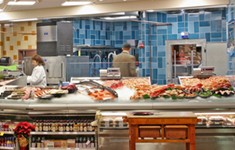
Other major challenges cited by retailers include: shoppers’ price resistance, consumers’ lack of knowledge about seafood, competition from supercenters and sustainability-related issues.
“Our wholesale prices have gone up 20 to 25 percent over the past year. Several other fish markets have gone out of business, but we hang on,” says Susan Shebilske, manager of one of four Madison, Wis.-based The Seafood Center stores. To stay in business, The Seafood Center stores do not invest in new equipment, and they have been forced to raise retail prices twice over the past year. In addition, some of the company’s stores have slashed their daily fresh seafood options from around 30 different species to around 20 species.
Wholesale prices at the Nantucket Shoals Seafood Market in Albuquerque, N.M., have also gone up 25 to 30 percent over the last year, says owner Nancy Chavez-Berg. “It is probably because I am very small — I am not a Walmart that can buy in bulk — but it is also because of the high cost to get it here,” says Chavez-Berg. She’s watched air-freight costs rise $1.15 a pound on average to ship seafood.
“Some prices have come down from last year, but most of them are up. It’s hard to keep your margins and you don’t want to scare people off,” says Ray Mullio, consultant for Original Fish Co., a fish market and restaurant in Los Alamitos, Calif. As a result, Original Fish Co. is carrying more of the seafood items that have declined in price this season, such as frozen halibut and shrimp, and less of species such as Alaska king crab that have been priced higher this year, according to Mullio.
Unfortunately, 54 percent of retailers surveyed said rising wholesale prices have hurt their seafood sales. “There seems to be a ceiling on how much you can charge for certain species. Sometimes you have to take a little loss on something to sell it all and make people happy,” says Shebilske. In addition to other cost-saving initiatives, The Seafood Center stores now carry less expensive seafood species. “We are trying to get customers to try new species that they may not have heard of before and may be just as tasty, such as corvina instead of grouper,” she says.
At a Hy-Vee store in Keokuk, Iowa, the seafood department has cut out about four seafood species that are typically priced higher, such as jumbo king crab legs, according to Tonie Jensen, meat department manager for the store.
Many other retailers are taking similar measures to cut costs. Sixty-one percent of the retailers surveyed said that consumers are switching to cheaper seafood species and 32 percent said their shoppers are switching to other center-of-the-plate proteins.
While retailers are concerned about rising wholesale costs, they believe that shoppers’ resistance to higher seafood prices has declined. Forty-nine percent said that customers’ price resistance was one of their biggest business challenges, compared to 55 percent in 2010. Instead, freshness and quality are shoppers’ top concern — 51 percent — in 2012, according to the retailers surveyed.
Sustainable sense
Shoppers are still concerned about whether their seafood is sustainable, but retailers say it is less of a challenge for them to handle than in past years. Only 19 percent of retailers said that sustainability-related issues were one of their biggest operating challenges, compared to 30 percent in 2010.
Still, retailers say the various sustainable-seafood lists and labels cause a lot of confusion among both shoppers and retailers. “There are all these lists — five or six different ones. On one list, the fish may be listed as ‘avoid,’ but on another it might be listed as a ‘good’ choice. It is very confusing to the customers,” says Shebilske.
“Retailers are more confused than most consumers about sustainability,” says Tom Waltimire, seafood-sourcing specialist for Jacksonville, Fla.-based Winn-Dixie Stores. However, Winn-Dixie carries mostly sustainable seafood because some of its shoppers are concerned about whether their seafood is sustainable or not.
Methodology
SeaFood Business’ biennial survey for the seafood retail industry was conducted online in May 2012. On May 8, 2012, 1,589 seafood retailers were invited to participate in the survey. The invitations were sent via email and 116 people responded for a 7.3 percent response rate.





